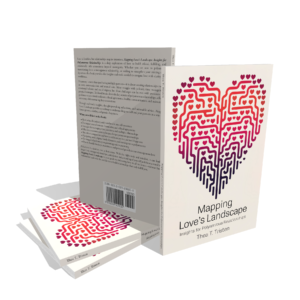Mapping Love’s Landscape: Complete Guide to Polyamorous Relationships and Ethical Non-Monogamy

Navigating polyamorous relationships requires more than good intentions—it demands practical tools, emotional intelligence, and clear communication strategies. If you’ve ever felt overwhelmed by the complexities of loving multiple partners ethically, you’re not alone. Many people struggle with jealousy management, time distribution, and creating healthy boundaries in non-monogamous relationships.
“Mapping Love’s Landscape: Insights for Polyamorous Relationships” offers a comprehensive roadmap for building fulfilling connections that honor everyone involved. Unlike other relationship guides that focus solely on theory, this book provides actionable strategies for real-world challenges that polyamorous individuals face daily. From transforming jealousy into self-awareness to establishing ethical agreements, this guide bridges the gap between polyamorous ideals and practical implementation.
Whether you’re new to ethical non-monogamy or transitioning from traditional monogamous relationships, this book meets you where you are in your journey. The author addresses common misconceptions while providing evidence-based approaches to relationship management, communication techniques, and emotional resilience building that actually work in practice.
What You’ll Discover
- Jealousy Transformation Techniques: Learn how to convert jealous feelings into opportunities for self-awareness and personal growth while strengthening your polyamorous relationships
- Ethical Agreement Frameworks: Master the art of creating clear boundaries and consensual guidelines that protect all partners while fostering trust and mutual respect
- Advanced Communication Strategies: Discover proven dialogue techniques and active listening skills that prevent misunderstandings and deepen emotional connections across multiple relationships
- Time Management Systems: Overcome scheduling challenges and energy distribution issues with practical systems for balancing multiple partners without burnout or neglect
- Compersion Cultivation Methods: Develop the ability to find genuine joy in your partner’s happiness with others, transforming competitive feelings into collaborative love
- Transition and Breakup Navigation: Handle relationship changes gracefully with tools for managing transitions, ending connections ethically, and maintaining dignity throughout difficult periods
Why This Book Matters
Polyamorous relationships often lack societal support systems and established guidelines that monogamous couples take for granted. This book fills that crucial gap by providing research-backed strategies specifically designed for ethical non-monogamy challenges. The practical approaches address real concerns like managing multiple emotional needs, handling social stigma, and building sustainable relationship structures that actually last.
Unlike academic theories or idealistic concepts, these proven methods focus on immediate implementation and measurable results. You’ll gain confidence in navigating complex emotional landscapes while building the skills necessary for long-term success in multiple-partner relationships. The transformation occurs through actionable steps rather than wishful thinking.
Key Features
This comprehensive ebook spans multiple detailed chapters covering essential polyamorous relationship topics from foundation-building to advanced relationship dynamics. Available as an instant digital download, you’ll receive immediate access to practical worksheets, communication templates, and boundary-setting exercises. The format allows for easy reading on any device, with printable resources for hands-on practice and reference. Also available as audiobook on Google Play Books and Spotify for convenient listening during commutes or workouts.
Frequently Asked Questions
How does this book help beginners navigate polyamorous relationships safely?
The book provides step-by-step guidance for establishing healthy foundations in ethical non-monogamy. You’ll learn essential communication skills, boundary-setting techniques, and emotional management strategies before diving into complex multi-partner dynamics. The progressive approach ensures you build confidence gradually while avoiding common beginner mistakes that can damage relationships.
Can these strategies help with jealousy management in existing polyamorous relationships?
Absolutely. The book offers proven techniques for transforming jealousy from a destructive force into an opportunity for personal growth and deeper connection. You’ll discover practical exercises for identifying jealousy triggers, communicating needs effectively, and developing compersion skills that strengthen rather than threaten your multiple relationships.
Does this guide address time management challenges with multiple partners?
Yes, the book includes comprehensive time and energy management systems specifically designed for polyamorous individuals. You’ll learn scheduling strategies, priority-setting frameworks, and boundary maintenance techniques that prevent burnout while ensuring all partners feel valued and respected in your relationship network.
Get Your Copy Today
Transform your approach to polyamorous relationships with this comprehensive guide to ethical non-monogamy. Available for instant download at just $6.99, this ebook provides exceptional value compared to expensive relationship coaching or therapy sessions focused on alternative relationship styles. Also available as audiobook on Google Play Books and Spotify for flexible learning. Purchase your copy through all major ebook retailers including Apple Books, Barnes & Noble, and Kobo to begin building healthier, more fulfilling multiple-partner relationships today.
Watch the Video Review

